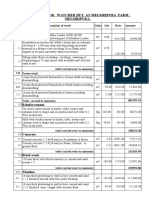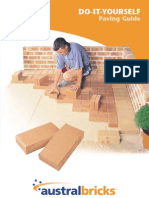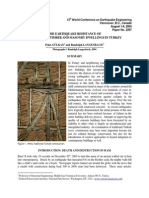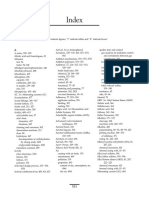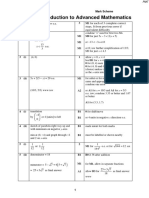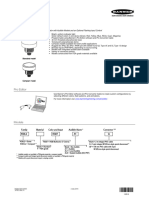Installation Guide: 1) Foundation Preparation
Installation Guide: 1) Foundation Preparation
Uploaded by
darkchechoCopyright:
Available Formats
Installation Guide: 1) Foundation Preparation
Installation Guide: 1) Foundation Preparation
Uploaded by
darkchechoOriginal Title
Copyright
Available Formats
Share this document
Did you find this document useful?
Is this content inappropriate?
Copyright:
Available Formats
Installation Guide: 1) Foundation Preparation
Installation Guide: 1) Foundation Preparation
Uploaded by
darkchechoCopyright:
Available Formats
INSTALLATION GUIDE
1) FOUNDATION PREPARATION
The foundation on which the gabions are to be placed shall be cut or filled and graded to the lines and grades shown on the drawings. Surface irregularities, loose material, vegetation, and all foreign matter shall be removed from foundation surface area. When fill is required, it shall consist of materials conforming to the specified requirements. Gabions and bedding or specified geotextiles shall not be placed until the foundation preparation is completed, and the subgrade surfaces have been inspected and approved by the engineer or the engineers representative. Compaction of bedding or filter material will be required per plans and specifications. The surface of the finished material shall be to grade and free of mounds, dips or windrows. Extra care should be taken with foundation preparations in order to ensure a level and smooth surface. Geotextile shall be installed in accordance with the requirements of the plans and specifications.
2) ASSEMBLY AND PLACEMENT
The assembly and placement of gabions shall be in accordance with the following procedures: Assembly. Rotate the gabion panels into position and join the vertical edges with fasteners for gabion assembly. Where lacing wire is used, wrap the wire with alternating single and double half hitches at intervals between 100) to 130 mm. Where spiral fasteners are used, crimp the ends to secure the spirals in place. Where ring type alternate fasteners are used for basket assembly, install the fasteners at a maximum spacing of 150 mm. Use the same fastening procedures to install interior diaphragms where they are required. Interior diaphragms will be required where any inside dimension exceeds 91 cm for gabion baskets thicker than 300mm. Diaphragms will be installed to assure that no open intervals are present that exceeds 91 cm. For baskets 300 mmor less rectangular cells are allowed with dimensions 91 cm in one direction and not to exceed 183 cm in the perpendicular direction. Placement. Place the empty gabions on the foundation and interconnect the adjacent gabions along the top, bottom, and vertical edges using lacing wire or spirals. Wrap the wire with alternating single and double half hitches at intervals between 100 mm and 150 mm. Spiral fasteners are commonly used for the assembly and interconnection of welded mesh gabions. Spirals are screwed down at the connecting edges then each end of the spiral is crimped to secure it in place. Lacing may be used as needed to supplement the interconnection of welded mesh gabions, and the closing of lids. Interconnect each layer of gabions to the underlying layer of gabions along the front, back, and sides. Stagger the vertical joints between the gabions of adjacent rows and layers by at least one-half of a cell length.
3) FILLING OPERATION
After adjacent empty wire gabion units are set to line and grade and common sides properly connected, they shall be placed in straight-line tension to gain a uniform alignment. Staking of the gabions may be done to maintain the established proper alignment prior to the placement of rock. No temporary stakes shall be placed through geotextile material. Connecting lacing wire and other fasteners (as allowed) shall be attached during the filling operation to preserve the strength and shape of the structure. Internal connecting cross-tile wires shall be placed in each unrestrained gabion cell greater than 500 mm in height, including gabion cells left temporarily unrestrained. Two internal connecting wires shall be placed concurrently with rock placement, at each 300 mm interval of depth. In welded mesh gabions these crossties or stiffeners will be placed across the corners of the gabions (at 300 mm from the corners) providing diagonal bracing. Lacing wire or preformed wire stiffeners may be used. The gabions shall be carefully filled with rock, either by machine or hand methods, ensuring alignment, avoiding bulges, and providing a compact mass that minimizes voids. At no point in the filling process may rock be mechanically placed from a height of over 91 cm from machine to fill area. Machine placement will require supplementing with handwork to ensure the desired results. The cells in any row shall be filled in stages so that the depth of rock placed in any one cell does not exceed the depth of rock in any adjoining cell by more than 300 mm. Along the exposed faces, the outer layer of stone shall be carefully placed and arranged by hand to ensure a neat, compact placement with a uniform appearance.
Updated September 2008 | www.permathene.com
The last layer of rock shall be uniformly leveled to the top edges of the gabions. Lids shall be placed over the rock filling using only approved lid closing tools as necessary. The use of crowbars or other single point leverage bars for lid closing is prohibited due to the potential for damage to the baskets. The gabion lid shall then be secured to the sides, ends, and diaphragms with spiral binders, approved alternate fasteners, or lacing wire wrapped with alternating single and double halfhitches in the mesh openings. Any damage to the wire or coatings during assembly, placement and filling shall be repaired promptly in accordance with the manufacturers recommendations or replaced with undamaged gabion baskets.
Updated September 2008 | www.permathene.com
Updated September 2008 | www.permathene.com
GAB/ON SYSTEMS
MODULAR GAB/ON SYSTEMS
(C) partially assembled gabions or mattresses.
Modular Gabions Systems (B) pre-cut panels or may be supplied in (A) roll form,
When using roll stock, begin the assembly process at Step 1.
When using preassembled gabions, When using pre-cut panels, proceed to Step 2 proceed to Step 3. Ends, diaphragms, front and back panels are placed upright on the bottom section of wire mesh.
Panels may be cut to appropriate sizes in the field. When using roll stock, bottoms, lids, fronts and backs may be rolled out in lengths up to 300'.
~ E a r t h Solutions
PERMATHENE
Secure panels by screwing spiral binders through the mesh openings in adjacent panels.
18 Stiffeners should be placed inside at 12 intervals (4 per cell)and crimped over the line and cross wires on the front and side faces. None are needed in interior cells.
Gabions may be filled with graded stone After filling, close the lid and secure by hand or with a backhoe or loader. with spiral binders at the diaphragms, ends, front and back.
All illustrations depict a 3' x 3' x 6' gabion. Gabions constructed from roll stock may utilize continuous sections of welded wire mesh up to 300' long. Please review the instructions on page 3 for options to eliminate redundant panels.
Redundant panels may be eliminated between gabions as illustrated. An end panel has been removed from the gabion on the right. This gabion will butt up against the gabion on the left so that the end panel of the left gabion becomes a diaphragm between the cells of the two gabions. Spiral connectors will secure all the adjoining panels.
Spirals will connect the gabions here End panel removed
When stacking tiers of gabions (or gabions on mattresses), the lid of the lower tier may serve as the base of the upper tier. Secure with spiral binders and add pre-formed stiffeners to exterior cells before filling with graded stones.
The lid of the lower tier of gabions now forms the base for the upper gabion.
This gabion has been assembled without a base.
All illustrations depict a 3' x 3' x 6' gabion. Gabions constructed from roll stock may utilize continuous sections of welded wire mesh up to 300' long. Please review basic assembly instructions on pages 1 & 2.
Disclaimer
The information presented herein, while not guaranteed, is to the best of our knowledge true and accurate. While every effort has been made to provide accurate and reliable information, it is up to the user of this brochure to verify all information, including designs it might be based upon, with an independent source. Application of this data must be made on the basis of responsible professional judgement. Except when agreed to in working conditions of use, no warranty expressed or implied is made regarding the performance of any product, since the manner of use and handling is beyond our control.
Legal | www.permathene.com
You might also like
- 2015 Yr11 Methods Sem2 Exam Calc SolutionsDocument20 pages2015 Yr11 Methods Sem2 Exam Calc Solutionszarina.munshiNo ratings yet
- Build 145 41 Design Right Bracing For Monopitch RoofsDocument2 pagesBuild 145 41 Design Right Bracing For Monopitch Roofssuejack2020No ratings yet
- 9 Understanding Analysis Failures and WarningsDocument6 pages9 Understanding Analysis Failures and WarningsSara RamliNo ratings yet
- How To Tie Rebar - 15 Steps (With Pictures) - Wikihow PDFDocument4 pagesHow To Tie Rebar - 15 Steps (With Pictures) - Wikihow PDFa769No ratings yet
- EzyBrace 2011 Technical BookDocument32 pagesEzyBrace 2011 Technical BookHaisheng YinNo ratings yet
- Gabions Install GuideDocument2 pagesGabions Install GuideTele2 Phone2100% (1)
- Installation Guide Reno Mattress - Rev01 EngDocument2 pagesInstallation Guide Reno Mattress - Rev01 Engvaskots100% (1)
- Painters Rates PDFDocument86 pagesPainters Rates PDFmanthoexNo ratings yet
- All CladdingDocument44 pagesAll CladdingalloytarungNo ratings yet
- Ret Walls DetailsDocument8 pagesRet Walls DetailstouchyarrowNo ratings yet
- CBB1443 How To Timber DeckDocument2 pagesCBB1443 How To Timber DeckTuroyNo ratings yet
- Monier Roofing Architectural Manual Section5Document13 pagesMonier Roofing Architectural Manual Section5Christian LlorcaNo ratings yet
- Wood DeckingDocument4 pagesWood DeckingDee Jay VillanuevaNo ratings yet
- Inspection: Sample Inspection Report: Inspector: John Brown Info@propertyinspector - Co.zaDocument14 pagesInspection: Sample Inspection Report: Inspector: John Brown Info@propertyinspector - Co.zaWalid SonjiNo ratings yet
- Build A Retaining WallDocument13 pagesBuild A Retaining WallAnonymous 1TTYYaNo ratings yet
- GazeboDocument1 pageGazeboChristopher NiadasNo ratings yet
- Floor Installation GuidelinesDocument52 pagesFloor Installation Guidelinesandy131078No ratings yet
- Retaining WallsDocument4 pagesRetaining Wallssnorburn1No ratings yet
- Design and Construction of Stone BuildingDocument2 pagesDesign and Construction of Stone BuildingMuhafeez GoolabNo ratings yet
- Construction of Barracks (2X20X12) For Security Guard at Kalabagh-1ADocument23 pagesConstruction of Barracks (2X20X12) For Security Guard at Kalabagh-1AAun Abbas SyedNo ratings yet
- 1.9E Microllam LVL Headers and Beams: Specifier'S GuideDocument20 pages1.9E Microllam LVL Headers and Beams: Specifier'S GuideChristine A. HobsonNo ratings yet
- Unit 4 - Roof ConstructionDocument30 pagesUnit 4 - Roof ConstructionAbrham TeklebrhanNo ratings yet
- Guttering and Steel FasciaDocument6 pagesGuttering and Steel FasciaJanine AndersonNo ratings yet
- BUILD116 40 BRANZ Renovation ProjectDocument2 pagesBUILD116 40 BRANZ Renovation ProjectJpver1000No ratings yet
- Tie BarsDocument18 pagesTie BarsKutty Mansoor100% (1)
- Pole Building Construction PDFDocument78 pagesPole Building Construction PDFjoebaffa100% (1)
- Pole Retaining Wall Design GuideDocument2 pagesPole Retaining Wall Design Guidethegerman11No ratings yet
- Method To Conserve Timber StructureDocument5 pagesMethod To Conserve Timber StructurePALKI GHAINo ratings yet
- How To Put Up CovingDocument7 pagesHow To Put Up CovingBob KowalskiNo ratings yet
- Affordable Green Roofing PDF Version 1.2Document14 pagesAffordable Green Roofing PDF Version 1.2Jonathan NorrisNo ratings yet
- Log Building News - Issue No. 76Document32 pagesLog Building News - Issue No. 76ursindNo ratings yet
- Roofs Best PracticeDocument43 pagesRoofs Best Practicesebastyan_v5466No ratings yet
- Replace Broken TilesDocument2 pagesReplace Broken TilesApollyonNo ratings yet
- Ceiling TechnologyDocument6 pagesCeiling Technologypdf2004No ratings yet
- B.O.Q Wacher Room MelsiripuraDocument17 pagesB.O.Q Wacher Room MelsiripuraChinthakaNo ratings yet
- DIY Paving PDF 31103601924Document4 pagesDIY Paving PDF 31103601924Laki RevellosNo ratings yet
- Measurement and SpecificationDocument14 pagesMeasurement and SpecificationThank GodNo ratings yet
- Disadvantages of WPC BoardDocument32 pagesDisadvantages of WPC BoardvidhiNo ratings yet
- MiTek Structural Fixings On-Site Guide 2012 PDFDocument124 pagesMiTek Structural Fixings On-Site Guide 2012 PDFragulan1983100% (1)
- Whitehouse Cost PlanDocument12 pagesWhitehouse Cost PlanblackwellkidNo ratings yet
- Straight Wall With English BondDocument20 pagesStraight Wall With English BondAre OnezNo ratings yet
- Convertible TableDocument18 pagesConvertible TableFrancisco Huor Melwasul MolinaNo ratings yet
- The Complete Guide To CovingDocument18 pagesThe Complete Guide To CovingisaacnewtonasimovNo ratings yet
- Pergolas and TrellisDocument11 pagesPergolas and TrellisPARVATHY R S 170564No ratings yet
- Tapered Insulation For Roof Slope DrainageDocument34 pagesTapered Insulation For Roof Slope DrainagebatteekhNo ratings yet
- PavingDocument25 pagesPavingVighnesh MalagiNo ratings yet
- Earthquake Resistant Housing PDFDocument11 pagesEarthquake Resistant Housing PDFBia MughalNo ratings yet
- Tongue and Groove Roof Decking: 2 Wood Construction DataDocument17 pagesTongue and Groove Roof Decking: 2 Wood Construction DataCraig J Lopez AiaNo ratings yet
- Hip and VallyDocument40 pagesHip and VallyKiran Kumar Kondapalli100% (1)
- The Earthquake Resistance of Traditional Timber and Masonry Dwellings in TurkeyDocument15 pagesThe Earthquake Resistance of Traditional Timber and Masonry Dwellings in TurkeyIvan LiewNo ratings yet
- Approved R&R GuidelinesDocument28 pagesApproved R&R GuidelinesRahul SatijaNo ratings yet
- Reporters: Clemente, John Andrei de Pedro, John Paul Fajardo, Xandra Ale Soriano, AlgernonDocument19 pagesReporters: Clemente, John Andrei de Pedro, John Paul Fajardo, Xandra Ale Soriano, AlgernonJogz de Pedro100% (1)
- Flat Roof Quick Guide 9th Issue Feb 16Document40 pagesFlat Roof Quick Guide 9th Issue Feb 16aadrian_xyzNo ratings yet
- Kokas CollectionDocument24 pagesKokas CollectionRossNo ratings yet
- Good Stoves Facilitation: How to Innovate and Change the WorldFrom EverandGood Stoves Facilitation: How to Innovate and Change the WorldNo ratings yet
- the artificial grass guide: design, estimating, installation and groomingFrom Everandthe artificial grass guide: design, estimating, installation and groomingNo ratings yet
- Installing a Garage Door and Opener- Special Bundle: Cake Decorating for BeginnersFrom EverandInstalling a Garage Door and Opener- Special Bundle: Cake Decorating for BeginnersNo ratings yet
- Module #10Document2 pagesModule #10Mary Grace BorinagaNo ratings yet
- Temperature Dependence and Dynamic Behavior of Full Well Capacity in Pinned Photodiode CMOS Image SensorsDocument8 pagesTemperature Dependence and Dynamic Behavior of Full Well Capacity in Pinned Photodiode CMOS Image SensorsJackNo ratings yet
- Grade 11 Trig FunctionsDocument64 pagesGrade 11 Trig Functionsxd2zncztzrNo ratings yet
- Year 8 Equations and Inequalities Advance EXAMDocument2 pagesYear 8 Equations and Inequalities Advance EXAMsaavir.aryaNo ratings yet
- Biermann's Handbook of Pulp and Paper - IndexDocument25 pagesBiermann's Handbook of Pulp and Paper - Indexchau_riberNo ratings yet
- Midterm1 Complex Physics 2022Document2 pagesMidterm1 Complex Physics 2022Yi DaiNo ratings yet
- Sony CDP S3.ServiceDocument36 pagesSony CDP S3.ServiceChef KaiserNo ratings yet
- Course Outline - Health Science I - Revised - 30 Aug 2013Document10 pagesCourse Outline - Health Science I - Revised - 30 Aug 2013Yip Ka YiNo ratings yet
- CHE 562 Note Set 8Document12 pagesCHE 562 Note Set 8rjeesNo ratings yet
- Module 1 1Document3 pagesModule 1 1Brian Paguio GalangNo ratings yet
- Problema 8.5Document6 pagesProblema 8.5miguel angel ceballos aguadoNo ratings yet
- Selection & Design of BLDC Motor For Different Applications: Priti S. Manware, Md. Bashir Sheikh and M.R. ShelkeDocument6 pagesSelection & Design of BLDC Motor For Different Applications: Priti S. Manware, Md. Bashir Sheikh and M.R. ShelkemitulNo ratings yet
- Test Standards ASTM D3330 Method A - GeneralDocument2 pagesTest Standards ASTM D3330 Method A - GeneralTayyab AwanNo ratings yet
- Design Change Request (DCR) : PT - Barata IndonesiaDocument1 pageDesign Change Request (DCR) : PT - Barata IndonesiaRhadityo Shakti BudimanNo ratings yet
- Comparison Theorems For Linear Differential Equations of Second Order - LeightonDocument8 pagesComparison Theorems For Linear Differential Equations of Second Order - Leightoniatrakisg8671No ratings yet
- January 2010 MS - C1 OCR MEIDocument6 pagesJanuary 2010 MS - C1 OCR MEIJosh KappaNo ratings yet
- Calibration Procedure FOR Digital Oscilloscope Wavesurfer 44Mxs-BDocument15 pagesCalibration Procedure FOR Digital Oscilloscope Wavesurfer 44Mxs-BlauguicoNo ratings yet
- Repulsion motorDocument12 pagesRepulsion motoraleodawy12100% (1)
- K50L2RGB7 Indicator - Datasheet - 197815Document6 pagesK50L2RGB7 Indicator - Datasheet - 197815faspNo ratings yet
- Fluid Mechanics 4: Dimensional Analysis and ModelingDocument29 pagesFluid Mechanics 4: Dimensional Analysis and ModelingRishaan SomurNo ratings yet
- Relative Equilibrium of LiquidsDocument15 pagesRelative Equilibrium of LiquidsLarissa RiveraNo ratings yet
- Ilovepdf MergedDocument42 pagesIlovepdf MergedharshvaardhanNo ratings yet
- TECHNICAL SCIENCES P1 GR10 MEMO NOV2018 - EnglishAfr 1Document11 pagesTECHNICAL SCIENCES P1 GR10 MEMO NOV2018 - EnglishAfr 1dimakatsoruth0No ratings yet
- Formation/Characteristics/Types/Uses of Liquid CrystalDocument13 pagesFormation/Characteristics/Types/Uses of Liquid CrystalBishesh MarasiniNo ratings yet
- Jockey in NFPA20, 2007 Hand BookDocument3 pagesJockey in NFPA20, 2007 Hand BookVipul GandhiNo ratings yet
- PTC - BSR.RVI.01 - BoreScope Visual Inspection Procedure (Rev.1)Document9 pagesPTC - BSR.RVI.01 - BoreScope Visual Inspection Procedure (Rev.1)Sang Nguyen Quang100% (1)
- Appointment OrderDocument1 pageAppointment OrderSanjiv PandeyNo ratings yet
- Term Paper Maths: Name: Kamaldeep Singh Course: B-Tech (Hons) M.E. Roll No.: A14 Section: A4005 REG. ID: 11011377Document24 pagesTerm Paper Maths: Name: Kamaldeep Singh Course: B-Tech (Hons) M.E. Roll No.: A14 Section: A4005 REG. ID: 11011377Kamaldeep SinghNo ratings yet
- Performance of Steel Monopole Transmission Towers in Various WindzonesDocument10 pagesPerformance of Steel Monopole Transmission Towers in Various Windzoneschandraippa2No ratings yet





































